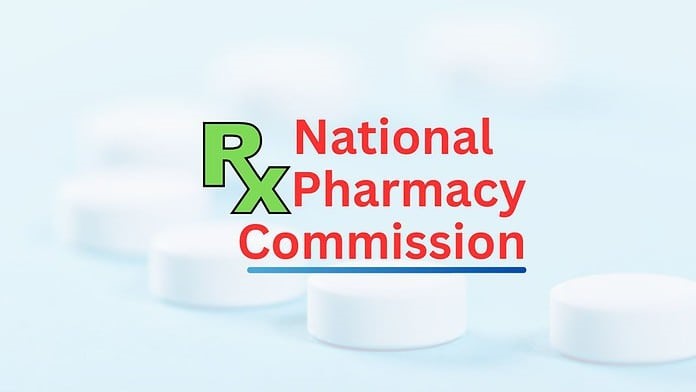Draft National Pharmacy Commission Bill, 2023
Context:
The draft National Pharmacy Commission Bill, 2023, recently introduced by the Union Ministry of Health and Family Welfare, marks a significant shift in India’s healthcare sector.
This proposed legislation seeks to replace the Pharmacy Act of 1948 and the existing Pharmacy Council of India (PCI) with the forward-thinking National Pharmacy Commission.
Key Points from the Bill
- Enhancement of Pharmacy Education: The primary objective is to improve access to affordable and high-quality pharmacy education, establishing a robust framework to prepare future professionals for excellence.
- Accessible Pharmacy Services: The bill aims to ensure universal access to pharmacy services, promoting equitable healthcare delivery nationwide.
- Integration of Research and Ethical Standards: It encourages pharmacy professionals to incorporate the latest research into their practice, contribute to ongoing research, and uphold the highest ethical standards.
- Transparency and Adaptability: Emphasizing regular transparent assessments, the bill calls for the creation of a national pharmacy register and flexibility to address evolving healthcare needs. Additionally, it introduces an effective grievance redressal mechanism.
Structure of the National Pharmacy Commission
Inception of a New Entity: The proposal suggests the creation of the National Pharmacy Commission, headquartered in New Delhi, leading to the dissolution of the current Pharmacy Council of India.
Composition: The commission will comprise a Chairperson, 13 ex-officio members, and 14 part-time members.
Three Key Boards: The Central Government will establish three crucial boards under the commission:
- Pharmacy Education Board
- Pharmacy Assessment and Rating Board
- Pharmacy Ethics and Registration Board
Empowering State Chapters
The bill mandates each State Government to establish a state pharmacy chapter within a year of the Act’s commencement.
- Operational Role: These chapters, operating under State Law, will play a pivotal role in executing the provisions of the Act.
National Pharmacy Register: Maintained by the Pharmacy Ethics and Registration Board, the National Pharmacy Register (NPR) will contain detailed information about pharmacy professionals, ensuring transparency and accountability.
Langlands Program
Context:
Renowned mathematician Robert Langlands, known for his groundbreaking “Langlands Program,” has redirected his attention to Turkish literature in his later years.
The program focuses on establishing profound connections between number theory (the study of numbers) and harmonic analysis (a mathematical approach that deconstructs functions or signals into simpler components).
Langlands Program: Bridging Diverse Mathematical Domains
- Inception: In 1967, Robert Langlands, then a young mathematician at Princeton, embarked on this journey by correspondingly sharing innovative concepts with fellow mathematician Andre Weil.
- Intricate Concepts: The program encompasses intricate concepts that prove challenging for even seasoned experts to fully grasp.
- Objective: The primary goal is to establish links between number theory and harmonic analysis, seemingly unrelated mathematical realms.
The Program’s Purpose
Abel’s Revelation: Niels Henrik Abel, in 1824, demonstrated the impossibility of finding a universal solution for specific complex mathematical equations (polynomial equations) beyond a certain level of complexity.
Galois’s Approach: Evariste Galois, unaware of Abel’s work, advocated examining patterns (symmetries) in the solutions of these equations instead of attempting direct solutions.
Galois Groups: These groups reveal patterns in equation solutions and play a crucial role in the Langlands Program.
Connecting Concepts: The program endeavors to correlate Galois groups with automorphic functions, enabling the utilization of calculus to explore equations, thereby connecting harmonic analysis and number theory.
Automorphic Functions: Unifying Varied Mathematical Realms
Illustration of Automorphic Function: Visualize functions with repetitive patterns, akin to the behavior of sine functions in trigonometry.
Distinct Symmetry: Automorphic functions possess a unique property—remaining unchanged after specific transformations, indicating a particular form of symmetry.
Role in Langlands Program: The program strives to establish connections between these distinct functions and Galois groups, offering novel approaches to comprehend and resolve mathematical challenges.
Impact of the Program
Resolving an Age-Old Enigma: In 1994, Andrew Wiles and Richard Taylor applied concepts from the Langlands Program to solve Fermat’s Last Theorem, a renowned and longstanding mathematical problem.
Creation of Novel Functions: The program contributes to the development of new types of automorphic functions, potentially aiding in solving other intricate mathematical problems, such as the Ramanujan conjectures.
Geometric Langlands: A branch of the Langlands Program exploring connections between diverse fields like algebraic geometry, representation theory, and even physics.
Math-Physics Nexus: Recent research indicates that the program may enhance understanding in physics, particularly in the study of electromagnetic waves.
Anti-Microbial Resistance
Context: The global observance of World Anti-Microbial Resistance Awareness Week is taking place from November 18th to 24th, 2023.
Definition of AMR:
- AMR is characterized by the ability of microorganisms to withstand the effects of previously effective medications.
- Microbes that exhibit resistance pose treatment challenges, necessitating the use of alternative medications or higher doses.
Types of Resistant Microbes: Microbes resistant to multiple antimicrobials are commonly referred to as Multi Drug Resistant (MDR) or Superbugs.
Causes of AMR:
- The increased use of antibiotics in both human and veterinary practices contributes to the development of AMR.
- Irrational consumption, including the overuse of broad-spectrum antibiotics, is a significant factor.
- Ineffective regulation, where existing standards may not monitor antibiotic residues in pharmaceutical industry effluents.
- Uncontrolled discharge of untreated urban waste is a contributor to AMR in many low and middle-income countries.
ICMR Study Findings (2022): The resistance level to broad-spectrum antimicrobials is observed to increase by 5-10% annually.
Impacts of AMR:
– Impact on Treating Infections:
- Resistance hampers the treatment of various infections such as pneumonia, tuberculosis, septicaemia, and food-borne diseases.
- Multidrug resistance significantly affects the global epidemic of tuberculosis.
- Health Cost: AMR imposes substantial health costs on patients, leading to prolonged hospitalization, health complications, and delayed recovery.
- Affects Vulnerable Patients: Increases the risks for patients undergoing major surgeries and treatments, such as chemotherapy.
– Disease Burden:
- Contributes to the burden of communicable diseases and strains a country’s health systems.
- In 2019, AMR was associated with approximately 4.95 million human deaths.
Efforts by India to Tackle AMR:
– Muscat Manifesto:
- Over 30 countries have adopted the Muscat Ministerial Manifesto on AMR.
- It emphasizes political commitments for implementing One Health Action to control AMR.
Targets from Muscat Manifesto:
- Reduce antimicrobial usage in the agri-food system by 30-50% by 2030.
- Eliminate the use in animals and food production of medically important antimicrobials.
- Ensure that 60% of overall antibiotic consumption in humans is from the WHO “Access” group by 2030.
Reporting to GLASS:
– India aims to strengthen private sector engagement and enhance data reporting to the WHO Global Antimicrobial Resistance and Use Surveillance System (GLASS).
National Initiatives:
– The National Action Plan on Antimicrobial Resistance (2017-21) focuses on hand hygiene, sanitation programs, and public health initiatives.
– The National Health Policy 2017 provides guidelines to limit antibiotic use, scrutinize prescriptions, and regulate usage in livestock.
Global Fisheries Conference India 2023
Context:
The inception of the Global Fisheries Conference India 2023 aimed to chart a course for the future of the Indian Fisheries and Aquaculture sector.
About Global Fisheries Conference:
- The Global Fisheries Conference India 2023 presents a distinctive opportunity, anticipating the convergence of diverse stakeholders on a unified platform.
- Global Participation: Anticipating over 5000 participants over two days, the event will feature multiple sessions fostering thought-provoking discussions and deliberations.
- Open forums: Simultaneous open forums for Government-to-Government (G2G)/Government-to-Business (G2B) and Business-to-Business (B2B) Bilaterals are scheduled.
Boosting the Fisheries Sector in India:
- The accompanying exhibition, hosting 200+ exhibitors, showcases a wide array of products, services, and innovations from startups, associations, cooperatives, self-help groups (SHGs), and small-medium enterprises in the sector.
A dedicated pavilion has been established to showcase selected startups specializing in Recirculating Aquaculture Systems (RAS), Artificial Reef, Seaweeds, Transponders, Raceways, Deep Sea Fishing Harbours, and more.
GOVERNOR’S POWERS ON BILL
Recently, the Supreme Court affirmed the Tamil Nadu government’s argument that the Constitution does not provide the Governor with the “discretion” to withhold the 10 Bills that were “re-passed” by the State Legislative Assembly Governor.
Governor’s Role:
- The Governor serves as the Chief Executive Head of a State, akin to the role of the President of India.
- In this capacity, they assume both a nominal (titular or constitutional) head and an agent of the central government, signifying a dual role for the office of the governor.
- Appointment: The President appoints the Governor.
- Oath: Administered by the Chief Justice of the concerned State’s High Court.
- Tenure: 5 Years.
Powers over State Bills:
- Article 200 of the Indian Constitution outlines the procedure for a Bill approved by the Legislative Assembly of a State to be presented to the Governor for assent.
- The Governor can either assent to the Bill, withhold assent, or reserve the Bill for consideration by the President.
- Additionally, the Governor has the option to return the Bill to the Legislative Assembly with a message, requesting reconsideration.
- Article 201 specifies that when a Bill is reserved for the President’s consideration, the President can either assent to or withhold assent from the Bill.
- Furthermore, the President has the power to instruct the Governor to return the Bill to the Legislative Assembly for reconsideration.
In the case of Nabam Rebia and Bamang Felix vs Deputy Speaker, it was established that the Governor cannot indefinitely withhold assent to a Bill but must return it to the Assembly with a message, which may include recommendations for amendments to the Bill.






